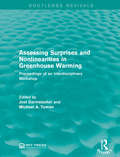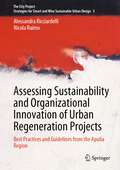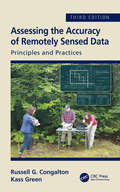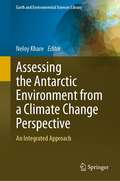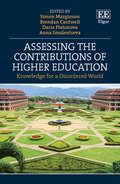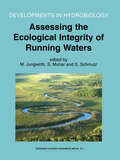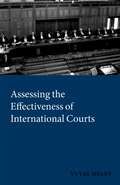- Table View
- List View
Assessing Study Abroad: Theory, Tools, and Practice
This book is intended to guide advisors, administrators, and faculty members engaged with study abroad who are concerned with answering the question: what does study abroad achieve? It will also inform the work of study abroad organizations as well as institutions receiving study abroad students. Offering a broad-based approach to assessment, the book will appeal to those starting out. However, an array of case studies, illustrating the often untidy process of implementation, will equally appeal to those further along by offering creative – and often simple – approaches to common problems. Following an account of how, and why, assessment in the field has evolved, the first part of the book sets the stage for the reader to consider the role of mission and context in determining purpose, goals and outcomes; to identify and consult with stakeholders; determine what data and expertise may already be available on campus; match methods and tools to questions; and create realistic plans to communicate findings, and to act upon them. The second part of the book offers an overview of appropriate tools and strategies for assessing study abroad, emphasizing the importance of carefully formulating and prioritizing assessment questions and understanding the advantages and drawbacks of different instruments. It describes an array of qualitative, quantitative, and mixed methods, illustrating their application with examples of practice, and concludes by outlining the process of putting a plan into action.The book concludes with ten case studies that illustrate various approaches to planning, experimentation, and implementation, some revealing false starts and lessons learned, and all conveying the message that assessment is an iterative, on-going process that needs constant refinement. The cases represent a wide variety of institutional and organizational types and demonstrate how each selected methods suited to their capacities and cultures.
Assessing Surprises and Nonlinearities in Greenhouse Warming: Proceedings of an Interdisciplinary Workshop (Routledge Revivals)
by Joel Darmstadter Michael A. TomanIn 1992, Resources for the Future conducted a workshop concerning the issues of global climate change. This title, originally published in 1993, is a collection of the revised versions of the papers commissioned for the workshop with an added introduction and overview. Each paper emphasises the potential nonlinearities or surprises in physical effects caused by humans loading the atmosphere with greenhouse gases and examines how shifts in the natural environment from climate change may affect human well-being. This collection is a valuable resource for any student interested in environmental studies and climate change issues.
Assessing Surprises and Nonlinearities in Greenhouse Warming: Proceedings of an Interdisciplinary Workshop (Routledge Revivals)
by Joel Darmstadter Michael A. TomanIn 1992, Resources for the Future conducted a workshop concerning the issues of global climate change. This title, originally published in 1993, is a collection of the revised versions of the papers commissioned for the workshop with an added introduction and overview. Each paper emphasises the potential nonlinearities or surprises in physical effects caused by humans loading the atmosphere with greenhouse gases and examines how shifts in the natural environment from climate change may affect human well-being. This collection is a valuable resource for any student interested in environmental studies and climate change issues.
Assessing Sustainability and Organizational Innovation of Urban Regeneration Projects: Best Practices and Guidelines from the Apulia Region (The City Project #3)
by Alessandra Ricciardelli Nicola RaimoThis book offers the first comprehensive report on the topic of organizational innovation and sustainability of urban regeneration from the public manager's perspective. Starting from a rich set of case studies on urban regeneration from the region of Apulia, in Italy, it develops a framework for measuring their sustainability performance. It proposes the use of indicators related to different aspects of the urban regeneration process, including the participations of stakeholders; land use and buildings; economy and jobs; transportation; environmental pollution; energy use; waste management; as well as open spaces and wildlife. This book offers extensive information to graduate students and researchers, and to authorities, developers, investors and stakeholders alike, involved in the design, planning and management, and sustainable development of urban spaces. It is expected to foster a better understanding of the level of organizational innovation and sustainability of urban regeneration projects and the role of governing bodies in their implementation.
Assessing Teacher, Classroom, and School Effects: A Special Issue of the Peabody Journal of Education
by Allan OddenFirst Published in 2004. Routledge is an imprint of Taylor & Francis, an informa company.
Assessing Teacher, Classroom, and School Effects: A Special Issue of the Peabody Journal of Education
by Allan OddenFirst Published in 2004. Routledge is an imprint of Taylor & Francis, an informa company.
Assessing Teacher Effectiveness: Different models
by Jim Campbell Leonidas Kyriakides Daniel Muijs Wendy RobinsonHow can we really evaluate teacher effectiveness? Systems of teacher appraisal and evaluation are being created across the world in order to monitor and assess teacher performance. But do the models used really give a fair evaluation? Based on international research, the authors argue that teacher effectiveness is too narrowly conceptualised and methods of measuring it are not attuned to the real contexts in which teachers work. They propose a model of differential teacher effectiveness which takes into account that: * teachers may be more effective with some categories of students than with others* teachers may be more effective with some teaching contexts than others* teachers may be more effective with some subjects or components than with others. Building on and developing previous research on models of teacher effectiveness and current theories, the authors open up possible new debates which will be of interest to academics and researchers working in this area throughout the world.
Assessing Teacher Effectiveness: Different models
by Jim Campbell Leonidas Kyriakides Daniel Muijs Wendy RobinsonHow can we really evaluate teacher effectiveness? Systems of teacher appraisal and evaluation are being created across the world in order to monitor and assess teacher performance. But do the models used really give a fair evaluation? Based on international research, the authors argue that teacher effectiveness is too narrowly conceptualised and methods of measuring it are not attuned to the real contexts in which teachers work. They propose a model of differential teacher effectiveness which takes into account that: * teachers may be more effective with some categories of students than with others* teachers may be more effective with some teaching contexts than others* teachers may be more effective with some subjects or components than with others. Building on and developing previous research on models of teacher effectiveness and current theories, the authors open up possible new debates which will be of interest to academics and researchers working in this area throughout the world.
Assessing Technology (UK Higher Education OUP Humanities & Social Sciences Education OUP)
by Richard KimbellHow did the development of assessment practices influence the emerging technology curriculum?How does practice in the UK compare to practice in the USA, Germany, Taiwan and Australia?For thirty years the UK has been evolving a distinctive technology curriculum. In part one of this book Richard Kimbell explores the thorny issues of assessment that have been raised by - and that helped to define - the technology curriculum in the UK. Richard writes as an 'insider' who was closely involved in the evolution of GCSE, in the battles that characterised the development of national curriculum assessment, and in the single biggest research venture in the assessment of technology - the Assessment of Performance Unit project of 1985-91. He analyses the successes and the mistakes and brings these together (in chapter 6) into a series of lessons that we should have learned about technology and about assessment.In part two, Richard presents four vignettes of curriculum and assessment practice in technology from the USA, Germany, Taiwan and Australia. In each case the education system, the technology curriculum and its associated assessment practices are outlined. Thereafter - in the final chapter, Richard brings together the lessons learned in the UK with those that might reasonably be learned from practice in the four case study nations.
Assessing the Accuracy of Remotely Sensed Data: Principles and Practices, Third Edition
by Russell G. Congalton Kass GreenThe past 10 years have brought amazing changes to the technologies used to turn remotely sensed data into maps. As a result, the principles and practices necessary for assessing the accuracy of those maps have also evolved and matured. This third edition of Assessing the Accuracy of Remotely Sensed Data: Principles and Practices is thoroughly updated and includes five new chapters. Now 15 chapters long, this text is the only one of its kind to provide geospatial analysts with the requisite considerations, tools, and theory necessary to conduct successful and efficient map accuracy assessments; and map users with the knowledge to fully understand the assessment process to ensure effective use of maps. See What’s New in the Third Edition: All original chapters have been updated to include new standards, practices, and methodologies. A new chapter on planning accuracy assessments. A new chapter on assessing maps created using object-based technologies. Two case study chapters - one showcasing the assessment of maps created from traditional methods, and one on the assessment of object-based maps. Emphasis on considering and planning for positional accuracy in concert with thematic accuracy. An appendix containing the internationally recognized ASPRS Positional Accuracy Standards. A new final chapter summarizing the key concepts, considerations and lessons learned by the authors in their decades of implementing and evaluating accuracy assessments. Assessing map accuracy is complex; however, the discussions in this book, together with the many figures, tables, and case studies, clearly present the necessary concepts and considerations for conducting an assessment that is both is practical, statistically reliable, and achievable.
Assessing the Accuracy of Remotely Sensed Data: Principles and Practices, Third Edition (Mapping Science Ser.)
by Russell G. Congalton Kass GreenThe past 10 years have brought amazing changes to the technologies used to turn remotely sensed data into maps. As a result, the principles and practices necessary for assessing the accuracy of those maps have also evolved and matured. This third edition of Assessing the Accuracy of Remotely Sensed Data: Principles and Practices is thoroughly updated and includes five new chapters. Now 15 chapters long, this text is the only one of its kind to provide geospatial analysts with the requisite considerations, tools, and theory necessary to conduct successful and efficient map accuracy assessments; and map users with the knowledge to fully understand the assessment process to ensure effective use of maps. See What’s New in the Third Edition: All original chapters have been updated to include new standards, practices, and methodologies. A new chapter on planning accuracy assessments. A new chapter on assessing maps created using object-based technologies. Two case study chapters - one showcasing the assessment of maps created from traditional methods, and one on the assessment of object-based maps. Emphasis on considering and planning for positional accuracy in concert with thematic accuracy. An appendix containing the internationally recognized ASPRS Positional Accuracy Standards. A new final chapter summarizing the key concepts, considerations and lessons learned by the authors in their decades of implementing and evaluating accuracy assessments. Assessing map accuracy is complex; however, the discussions in this book, together with the many figures, tables, and case studies, clearly present the necessary concepts and considerations for conducting an assessment that is both is practical, statistically reliable, and achievable.
Assessing the Antarctic Environment from a Climate Change Perspective: An Integrated Approach (Earth and Environmental Sciences Library)
by Neloy KhareThe present book covers diversified contributions addressing the impact of climate change on the Antarctic environment. It covers the reconstruction of environmental changes using different proxies. The chapters focus on the glacial history, glacial geomorphology, sedimentology, and geochemistry of Antarctic region. Furthermore, the Cenozoic evolution of the Antarctic ice sheet is discussed along with a Scientometrics analysis of climate change research. The book serves as a useful reference for researchers who are fascinated by the polar region and environmental research.
Assessing the Balance of Power in Central-Local Relations in China (Routledge Contemporary China Series)
by John DonaldsonHow do we understand the evolution of central-local relations in China during the reform period? This book addresses this question by focusing on eight separate issues in which the central-local relationship has been especially salient – government finance, investment control, regional development, administrative zoning, implementation, culture, social welfare and international relations. Each chapter introduces a sector and the way the center and various local governments have shared or divided power over the different periods of China’s reform era. The balance of power is gauged dynamically over time to measure the extent to which one level of government dominates, influences or shares power in making decisions in each of these particular domains, as well as what is likely to occur in the foreseeable future. The authors assess the winners and losers of these changes among key actors in China’s society. The result provides a dynamic view of China’s changing power relations.
Assessing the Balance of Power in Central-Local Relations in China (Routledge Contemporary China Series)
by John A. DonaldsonHow do we understand the evolution of central-local relations in China during the reform period? This book addresses this question by focusing on eight separate issues in which the central-local relationship has been especially salient – government finance, investment control, regional development, administrative zoning, implementation, culture, social welfare and international relations. Each chapter introduces a sector and the way the center and various local governments have shared or divided power over the different periods of China’s reform era. The balance of power is gauged dynamically over time to measure the extent to which one level of government dominates, influences or shares power in making decisions in each of these particular domains, as well as what is likely to occur in the foreseeable future. The authors assess the winners and losers of these changes among key actors in China’s society. The result provides a dynamic view of China’s changing power relations.
Assessing the Benefits and Costs of ITS: Making the Business Case for ITS Investments (Transportation Research, Economics and Policy)
by David Gillen David LevinsonThe 17 chapters in this book, which evolved from a conference on measuring the contributions of ITS sponsored by the California Department of Transportation in February 2002, examine the costs and benefits of ITS in an economic and business policy context. Section 1 examines the broad theme of how and what ITS contributes to the economy and how one makes a business case for ITS. Section 2 includes three chapters on ITS applications in mass transit. Section 3 explores ITS applications in the automobile/highway system. Section 4 considers integrative issues including how ITS is perceived and how it can be positioned to improve surface transportation. This volume will be especially useful to researchers and policy makers working in transportation, transportation engineering, and the economic analysis of transportation systems.
Assessing the Contributions of Higher Education: Knowledge for a Disordered World
Despite the broad engagement of higher education institutions in most social sectors, limited thinking and hyper-individualistic approaches have dominated discussions of their value to society. Advocating a more rigorous and comprehensive approach, this insightful book discusses the broad range of contributions made by higher education and the many issues entailed in theorising, observing, measuring and evaluating those contributions.Prepared by a group of leading international scholars, the chapters investigate the multiple interconnections between higher education and society and the vast range of social, economic, political and cultural functions carried out by universities, colleges and institutes and their personnel. The benefits of higher education include employable graduates, new knowledge via research and scholarship, climate science and global connections, and the structuring of economic and social opportunities for whole populations, as well as work and advice for government at all levels. Higher education not only lifts earnings and augments careers, it also immerses students in knowledge, helps to shape them as people, and fosters productivity, democracy, tolerance and international understanding. The book highlights the value added by higher education for persons, organisations, communities, cities, nations, and the world. It also focuses on inequalities in the distribution of that value, and finds that the tools for assessing higher education are neither adequate nor complete as yet.International and interdisciplinary in scope, this book will prove an invaluable resource to students and scholars of higher education, educational policy and social policy. It will also prove a useful resource to both university executives and tertiary education policymakers who want to make higher education more effectively accountable to the public.
Assessing the Demographic Impact of Development Projects: Conceptual, methodological and policy issues (Routledge Revivals)
by A. S. OberaiFirst published in 1992, Assessing the Demographic Impact of Development Projects based on studies in developing countries focuses on conceptual, methodological and policy issues related to development projects. It considers whether demographic effects can be assessed and why development planners should be interested in such an assessment. A.S. Oberai examines the extent to which economic and social changes generated by specific development interventions have influenced demographic behaviour in a particular context. He suggests how desired effects can be enhanced and undesired effects minimized by policy makers and planners in developing countries in order to deal with problems of population growth and its distribution. The major shortcomings of existing methodologies are identified, and the author indicates the future direction which research might take in order to be more scientifically valid and useful to policy makers. This book is a must read for scholars and researchers of development studies, political economy and labour economy.
Assessing the Demographic Impact of Development Projects: Conceptual, methodological and policy issues (Routledge Revivals)
by A. S. OberaiFirst published in 1992, Assessing the Demographic Impact of Development Projects based on studies in developing countries focuses on conceptual, methodological and policy issues related to development projects. It considers whether demographic effects can be assessed and why development planners should be interested in such an assessment. A.S. Oberai examines the extent to which economic and social changes generated by specific development interventions have influenced demographic behaviour in a particular context. He suggests how desired effects can be enhanced and undesired effects minimized by policy makers and planners in developing countries in order to deal with problems of population growth and its distribution. The major shortcomings of existing methodologies are identified, and the author indicates the future direction which research might take in order to be more scientifically valid and useful to policy makers. This book is a must read for scholars and researchers of development studies, political economy and labour economy.
Assessing the Different Roles of Marketing Theory and Practice in the Jaws of Economic Uncertainty: Proceedings of the 2004 Academy of Marketing Science (AMS) Annual Conference (Developments in Marketing Science: Proceedings of the Academy of Marketing Science)
by Harlan E. SpottsThis volume includes the full proceedings from the 2004 Academy of Marketing Science (AMS) Annual Conference held in Vancouver, Canada, entitled Assessing the Different Roles of Marketing Theory and Practice in the Jaws of Economic Uncertainty. It include papers aimed to create awareness of the issues, trends, and advances associated with current marketing theories and practices. Founded in 1971, the Academy of Marketing Science is an international organization dedicated to promoting timely explorations of phenomena related to the science of marketing in theory, research, and practice. Among its services to members and the community at large, the Academy offers conferences, congresses and symposia that attract delegates from around the world. Presentations from these events are published in this Proceedings series, which offers a comprehensive archive of volumes reflecting the evolution of the field. Volumes deliver cutting-edge research and insights, complementing the Academy’s flagship journals, the Journal of the Academy of Marketing Science (JAMS) and AMS Review. Volumes are edited by leading scholars and practitioners across a wide range of subject areas in marketing science.
Assessing the Ecological Integrity of Running Waters: Proceedings of the International Conference, held in Vienna, Austria, 9–11 November 1998 (Developments in Hydrobiology #149)
by M. Jungwirth S. Muhar S. SchmutzThe assessment of the ecological integrity of running waters is a prerequisite to an understanding of the effects of human alterations. The evaluation of degradation processes provides key information on how to avoid further negative impacts. The success of future conservation, mitigation and restoration activities will rely on sound assessment methodologies and their ecological relevance and applicability. Assessment methodologies are therefore an integral part of sustainable river management. This book synthesizes and discusses state-of-the-art experiences in assessment methodologies. Including the latest knowledge on structures, processes and functions of running waters as a fundamental basis for developing adequate assessment methods, the book focuses on method development, application, and in particular on integrated assessment methods. This book is directed at scientists and managers with the aim of more effective preservation, restoration and maintenance of the ecological integrity of running water ecosystems.
Assessing the Economic Impact of Tourism: A Computable General Equilibrium Modelling Approach
by Samuel Meng Mahinda SiriwardanaThis book employs a computable general equilibrium (CGE) model – a widely used economic model which uses actual data to provide economic analysis and policy assessment – and applies it to economic data on Singapore’s tourism industry. The authors set out to demonstrate how a novice modeller can acquire the necessary skills and knowledge to successfully apply general equilibrium models to tourism studies. The chapters explain how to build a computable general equilibrium model for tourism, how to conduct simulation and, most importantly, how to analyse modelling results. This applied study acts as a modelling book at both introductory and intermediate levels, specifically targeting students and researchers who are interested in and wish to learn computable general equilibrium modelling. The authors offer insightful analysis of Singapore’s tourism industry and provide both students and researchers with a guide on how to apply general equilibrium models to actual economic data and draw accurate conclusions.
Assessing the Economic Impact of Tourism: A Computable General Equilibrium Modelling Approach
by Samuel Meng Mahinda SiriwardanaThis book employs a computable general equilibrium (CGE) model – a widely used economic model which uses actual data to provide economic analysis and policy assessment – and applies it to economic data on Singapore’s tourism industry. The authors set out to demonstrate how a novice modeller can acquire the necessary skills and knowledge to successfully apply general equilibrium models to tourism studies. The chapters explain how to build a computable general equilibrium model for tourism, how to conduct simulation and, most importantly, how to analyse modelling results. This applied study acts as a modelling book at both introductory and intermediate levels, specifically targeting students and researchers who are interested in and wish to learn computable general equilibrium modelling. The authors offer insightful analysis of Singapore’s tourism industry and provide both students and researchers with a guide on how to apply general equilibrium models to actual economic data and draw accurate conclusions.
Assessing the Economic Value of Anticancer Therapies (Recent Results in Cancer Research #148)
by Niels NeymarkWith ever increasing demands on the constrained resources available for health care services, no one involved in decision making in health care can continue to ignore the economic costs of the services provided or the relative value for money offered by the available treatments. Economic evaluation has therefore become an important and indispensable tool for medical deci sion making, alongside the well-known methods for clinical eval uation. This is also true for cancer, despite the aura of sanctity often of surrounding this dreaded disease and the apparent willingness the general population to spend large sums in this area and do "everything possible" for the patients. In recent years, articles dealing with assessing the costs and benefits of various cancer treatments have begun to appear in scientific medical and eco nomic journals. This book provides a comprehensive survey and assessment of the current state of the art of economic evaluations and cost ana lyses in cancer. It gives an introduction to the methods available for economic evaluations, before surveying and assessing the available publications. Separate chapters are devoted to the most prevalent cancers, and in each chapter the current clinical prac tice and research problems are summarized in order to provide a background for the economic analyses. At the end, a summary assessment of the literature is provided along with some sugges tions for a future research agenda.
Assessing the Economic Value of Venture Capital Contracts: An Option Pricing Approach (ebs-Forschung, Schriftenreihe der EUROPEAN BUSINESS SCHOOL Schloß Reichartshausen #78)
by Jil Caroline OnimusDr. Jil Caroline Onimus identifies the baskets of real options embedded in model venture capital contracts as published by the National Venture Capital Association (NVCA) and shows how they can be priced in interaction using Least Squares Monte Carlo simulation.
Assessing the Effectiveness of International Courts (International Courts and Tribunals Series)
by Yuval ShanyAre international courts effective tools for international governance? Do they fulfill the expectations that led to their creation and empowerment? Why do some courts appear to be more effective than others, and do so such appearances reflect reality? Could their results have been produced by other mechanisms? This book evaluates the effectiveness of international courts and tribunals by comparing their stated goals to the actual outcomes they achieve. Using a theoretical model borrowed from social science, the book assesses their effectiveness by analysing key empirical data. Its first part is dedicated to theory and methodology, laying out the effectiveness model, explaining its different components, its promise and limits, and discussing the measurement challenges it faces. The second part analyses the role that indicators such as jurisdiction, judicial independence, legitimacy, and compliance play in achieving effectiveness. Part three applies the effectiveness model to the International Court of Justice, the WTO dispute settlement mechanisms (panels and Appellate Body), the International Criminal Court, the European Court of Human Rights, and the European Court of Justice, reflecting the diversity of the field of international adjudication. Given the recent proliferation of international courts and tribunals, this book makes an important contribution towards understanding and measuring the value that these institutions provide.

